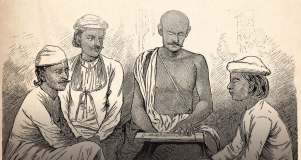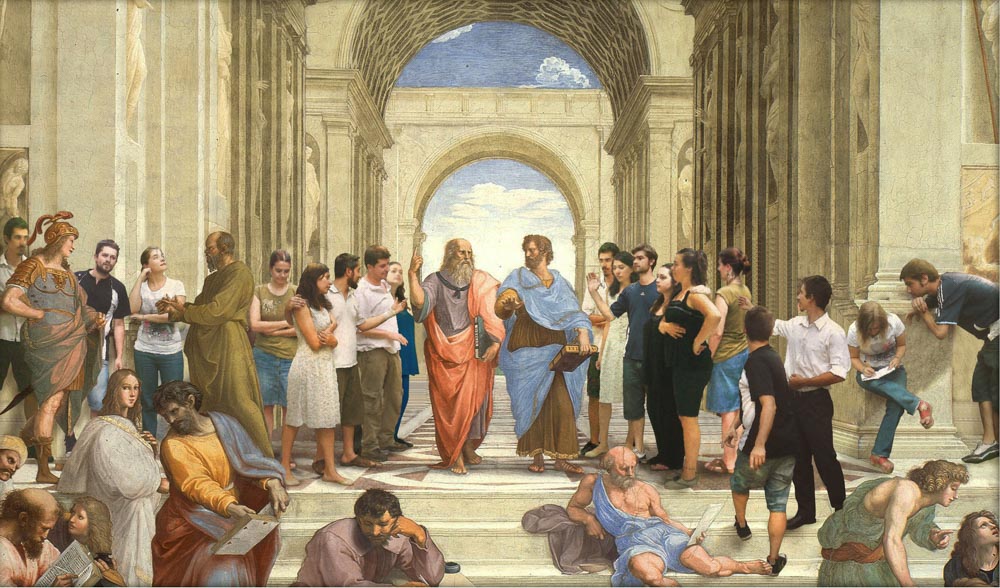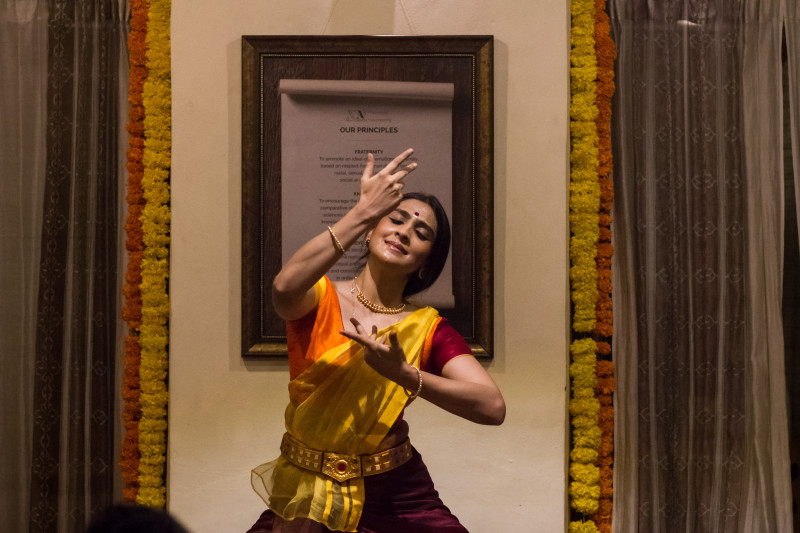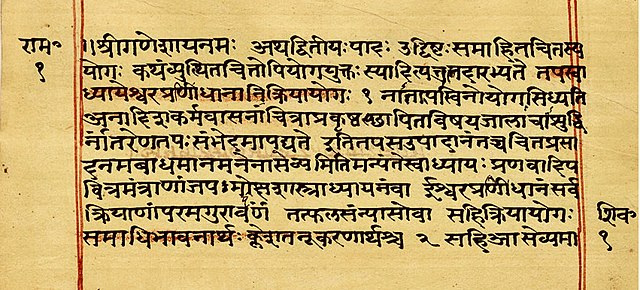The Darshanas: Six Schools of Indian Philosophy
Article By Manjula Nanavati
 “Truth is one. Sages call it by different names.” – Rig Veda
“Truth is one. Sages call it by different names.” – Rig Veda
The six darshanas are philosophical systems, or schools of thought, that take their authority from the Vedas. As implied by the meaning of the word darshana, to see or to experience, the six disciplines offer unique points of view, six separate windows from which to observe and comprehend Life, six seemingly disparate paths leading towards the one Ultimate Reality through the removal of ignorance of the nature of existence, liberation from suffering, and the attainment of enlightenment.
Each darshana is scientific in approach, with a doctrine based on logic and critical arguments. Each has an epistemology (theory of knowledge), a cosmogony (theory of creation), a metaphysical view of reality that could be theistic or atheistic, a strong ethical framework, and tools to validate and substantiate the system.
Each darshana was codified by a founding sage, who also composed explanatory verses, sutras, to elucidate its meaning, to serve as a guide or manual towards the recognition of a higher, more meaningful life. Accordingly, these six important philosophical texts are:
Sankhya Sutras of Kapila
Yoga Sutras of Patanjali
Nyaya Sutras of Gautama
Vaisheshika Sutras of Kannada
Mimamsa Sutras of Jaimini
Brahma Sutras (also called Vedanta Sutras) of Badrayana
The word sutra means thread or string, implying that they bind together in written form, a previously oral tradition. More prosaically, the sutras were first written on leaves which were then bound together with string. Whatever the origin of the term, the sutra is a series of aphorisms that contains a thought, an idea, a statement or an argument expressed in a brief, condensed phrase, dense with meaning, and therefore open to different interpretations. For this reason, the darshanas have traditionally required scholarly attention to be unveiled, in contrast to the Indian epics, which dispensed wisdom in a more accessible manner.
Any attempt to explain the substance and significance of each of these schools in a few paragraphs would not do justice to the depth of complexity and crest of insight that they encompass. It is my humble endeavour to encapsulate in a brief thumbnail sketch, a few distinguishing features of each that I have managed to extract, hoping that it will perhaps invite readers to delve further into an enlightening investigation of their own. To that end, The Six Systems Of Indian Philosophy by Sain Dass Aeri, from which the backbone of this article was gleaned, is an illuminating read.
SANKHYA
“Reflection is to be aware of what one knows, or what one does not know.” (Aeri)
Sankhya attempts to understand the cosmos through reason and logic. One of its main threads is Unity and the interdependence of our universe, which was not created by any external force, such as a God. Instead, this system speaks of two eternal entities in the universe, having no beginning or end; they are Prakriti or Infinite Unconsciousness (nature, matter in potential), and Purusha, or Infinite Consciousness (spirit). Prakriti when manifest is changeable, while Purusha is unchangeable. Creation begins when Purusha and Prakriti come closer together. At a point these two elements begin to move away from each other, hence resulting in a continuous alternating cycle of transformation and dissolution.
Human suffering is understood to be a result of the inability to discern between the changeable and unchangeable, between the transitory and the eternal. The path of liberation from pain is therefore through discriminatory knowledge and reflection. All religious practices, rituals, sacrifices, devotion, meditation, etc. can provide temporary respite, but only reason and right knowledge can lead to the Truth of the Self, of Life, and of the Ultimate Reality. Even an ethical life only facilitates this journey, but is not enough by itself. The solution lies only in the ability to discriminate our empirical self from our essential real self, between the perishable and the imperishable.
Thus, Sankhya was the first Indian school of thought to prioritize the human faculty of reason to find answers to the metaphysical questions of life. It did not depend on a God to help find a way out of pain and suffering, nor to provide ready-made answers to the questions about the creation and destruction of the world. Therefore, in its origination, the classic Sankhya is considered by some to be atheistic.
YOGA
“To understand the ultimate supreme reality as it is, rather than as we want it to be, we need a mind which is calm, clear and unbiased.” (Aeri)
“God’s grace is a great help, a great aid but the final onus is on our individual efforts. The final responsibility is always on us, not on God.” (Aeri)
Because Sankhya and Yoga share similar epistemologies they are sometimes combined together into Sankhya-Yoga, yet there are fundamental differences between the two. The most important of which is that, while Sankhya believes in knowledge as a means to liberation, Patanjali taught that through Yoga, this could be achieved by restraining the mind, leading an ethical life, combined with a firm belief in the grace of God.
Today Yoga has become synonymous with the postures or asanas that emphasize only the physical aspect. Patanjali’s Yoga, however, was conceived of as a physiological, spiritual, and philosophical system, comprising eight limbs. The first four – Yama (abstinences), Niyama (injunctions), Asana (postures), and Pranayama (breath control) were concerned with perfecting the practitioner’s physiological form. The other four – Pratyahara (withdrawal of the senses) Dharana (concentration) Dhyana (contemplation) and Samadhi (oneness, integration), were designed to perfect the inner state. In this manner moving slowly from the outside, into the depths of an inner world, the seeker can be led to a state of tranquility. Each component was not an end in itself, but only a means to the final aim of Yoga, which is Moksha.
Patanjali listed various obstacles that could hinder progress, such as the products of our mind and temperament. He suggested two ways to deal with them: the steadfast practice of virtues, and reflection, which encompasses observing our behavior and enquiring into the why of it.
According to Patanjali, with the increasing discovery of the real self, a process called Vairagya (non-attachment) is naturally set in motion. A word of caution must be noted here. It is not the aim of Yoga to engender a lack of interest in pleasure, or in life itself. Vairagya can be understood as “enjoying pleasure as a witness rather than as a participant.” (Aeri) It is the expression of a calm, stable, serene mind, and at that stage when one is no longer controlled by the mind, true freedom has been achieved.
NYAYA
“God can be experienced, not known through logic.” (Aeri)
In a broad sense Nyaya means a process of reasoning or syllogistic reasoning based on logic. In popular usage Nyaya also means justice. The Nyaya texts are a study of formal logic, but ultimately their focus, like every other Indian philosophical system, is Life. The Nyaya school of thought asserts that human suffering is a product of erroneous knowledge and Gautama, the author of the Nyaya Sutras, developed a theory of fallacy as a means to identify errors in the logical progression of thought. He believed that while the aim of life is to seek everlasting happiness, one has to first prove to oneself beyond doubt, that such a state of reality exists, and then uncover the processes that can be used to grasp it.
While Nyaya discusses different kinds of proofs of validity including perception, inference, comparison and verbal testimony, it upholds that the best is intuition, knowledge that does not rely on reason or any external logic. It is “knowledge whose instrumental cause is not knowledge,” but is something you deeply and directly know. (Aeri) The aim of Nyaya is to gain moksha through true knowledge, or higher, supreme knowledge. This is the knowledge that can discriminate between right and wrong, between what is disputable and indisputable, between the particular and the universal, between the body and soul.
As the tradition of logic is attributed to Aristotle by some in western Philosophy, Gautama is credited with systematizing the rules of logic in Indian Philosophy. His work on syllogisms and causation theory parallels Aristotle’s and his Theory of Fallacy is used in some measure by all Indian philosophies. He is said to be the first to subject the universal questions of human existence to a logical, critical, scientific methodology and he is also credited for providing a logical rationale to interpret the Vedas and the sacrificial religious practices contained in them.
VAISHESHEKA
“Salvation (Moksha) is not a journey to another world; it is a realization of our original nature and detachment from action.” (Aeri)
Nyaya and Vaishesheka share similar metaphysics and borrowed liberally from each other. Therefore, even though they evolved as separate disciplines, they are often fused together and called Nyaya-Vaishesheka. Vaishesheka elaborates that within every object there is a certain inherent, irreducible quality which is Vishesh (particular) and which distinguishes it from all other objects. It is the essence of that substance. Kanada, the author of Vaishesheka Sutras was also known as Kanabhaska, the atom eater, because of his work on the smallest particles of the universe which he called Paramanu (parama: most distant, and anu: very small.) Today his work is recognized as a rudimentary form of Atomic theory. Some of his ideas are very similar to his contemporary, the Greek philosopher Democritus known as the founder of Atomic theory. Though there are differences in their hypotheses, both Democritus and Kanada believed that the atom was the smallest, indivisible, imperceptible part of a substance and that atoms could neither be created nor destroyed.
Vaishesheka believes that since atoms are eternal, the universe made up of atoms is eternal also. Castles may perish but stones remain. Elements may disappear, but their atoms will remain, to recombine in an endless process. Just as the western world’s first scientists were ancient philosophers investigating nature and life, so also Kanada’s system, known for its insights in Naturalism and Physics allowed for a practical approach to life and its primary purpose, salvation. Vaishesheka endorsed the idea that we must follow the message of the Vedas to lead an ethical life. Every action attaches merits and demerits to the soul according to the law of Karma. These merits and demerits, combined with an unseen moral power guided by God, imparts motion to atoms leading to the creation of circumstances in which the individual soul experiences the justice of the law. Liberation lies in the cessation of deeds and actions that create Karma, which is only possible through detachment in the action. Vaishesheka emphasizes the value of knowledge from the world of experience as the path to moksha or salvation.
Purva Mimamsa
“Meanings of words come alive only through action, not through explanation.” (Aeri)
The word mimamsa means a reflection, investigation, or analysis. In the context of this darshana, it refers to the enquiry into the nature of Dharma, or a code of conduct in its ritualistic, ceremonial, and sacrificial sense. It is said that during this time the increasing authority of the priestly class and their multitudinous interpretations of the ‘correct’ rules of rituals resulted in a majoritarian backlash. Buddhism in particular questioned the validity of meaningless rituals devoid of a logical or philosophical basis. Jaimini studied and investigated the practices of the time, examined their objectives, and prepared a valid philosophical rationale for them. He believed that the Vedas were eternal and the Vedic rituals, combined with an ethical life, was the way to Salvation.
Because the Vedas were handed down orally the relationships between the word, the sound, and the meaning were considered to be critical. Mimamsa believed that words carry meaning, but only sentences carry knowledge, and that all valid knowledge must result in a duty to act. Practitioners of this stream were concerned with the idea of the highest good and contended that it was the result of ethical actions. Since, this was the subject matter of the Vedas, it was critical to properly understand and interpret its words. Mimamsa scholars investigated the philosophy of language, and how human beings learn and communicate knowledge across generations. They delved deeply into semantics and linguistics and considered the purpose of language was to clearly prescribe the right.
By connecting Dharma to Vedic religious practices, the Mimamsa school of thought became in time the backbone of the Hindu way of life. According to Jaimini, Dharma is an imperative carrying Vedic authority. Human beings cannot escape the compulsion of Dharma. When confronted with a choice, we have the freedom to act, but once a choice is made, the law of Karma is set in motion. This continues eternally in a cycle of action and consequence, over incarnations. Liberation comes only when the soul no more has the need or desire to act.
Is this concept of an action-less state possible on earth? Mimamsa believes that the cycle of birth and death may continue even when one attains Moksha, but the soul with no motives, desires or needs enjoys its pure natural uncontaminated state.
Uttara Mimamsa or Vedanta
While Purva Mimamsa focused on the kind of actions we should do, Uttara Mimamsa gave us the philosophical foundation behind our actions. Also called Vedanta, from anta meaning end, implying that it comprised the essence of the wisdom of the Vedas, it stressed a contemplative life of reflection and meditation.
The Brahma Sutras were authored by Badrayana and its central message is that there is only one Supreme Truth, one Ultimate Reality called Brahman. To know or realize Brahman is the most important goal of life. Brahma-Vidya is the knowledge of Brahman: to know what is, what exists, and what does not exist. Its four principal tenets are expressed in four widely quoted aphorisms:
| Aham Braham asmi
Ayam atma Brahma Tat tvam asi Sarvam khalvidam Brahama |
I am Brahman
This atma is Brahman Thou art that All that is Brahman |
According to Badrayana everything is Brahman. Atma and Brahma are qualitatively the same. God and this world are not separate, although this is not clear to us due to ignorance. By meditating deeply, through a life of reflection, one can pierce the veils of Maya to understand the true nature of Brahman.
Though the Brahma Sutra texts are complex, ambiguous, and seemingly contradictory, at least 10 different schools of Vedanta find their roots here. The most distinguished and acclaimed of Indian philosophers of this school are Adi Shankara, credited with the spread of Advaita Vedanta, and Ramanuja, the chief proponent of Visishta Advaita Vedanta. Their writings and commentaries on the Brahma Sutras, still influential today, contributed towards the popularization of this philosophical system.
Conclusion
The extraordinary diversity of ideas contained in the Vedas is staggering. Scholars have found verses within it that support Monism, Monotheism, Polytheism, Pantheism and even Atheism. This speaks eloquently of a long and ancient practice of open-mindedness, tolerance and objectivity, and that fundamentally these are all perhaps different perspectives to a singular reality. While each darshana accepted the authority of the Vedas, it was not a blind acceptance. The authors used a rigorous validating process, subjecting each assumption to deep analysis and stringent rules of logic and linguistics, before perfecting the system of thought. In their early years, the codified darshanas were characterized by healthy arguments and refutations debated by the various schools. This served to clarify and strengthen each codex with the result that the six darshanas give us six uniquely different, but coherent systems to use, to holistically understand life.
But above all, each darshana begins with the firm belief that a spiritual temperament is a pre-requisite to fathom the nature of Life. Perhaps this implies that life’s truth cannot be fully comprehended by reason alone. To be able to achieve a deeper understanding, there is a need to adhere to the Vedic injunction to know ourselves as a call to look deeper within, to purify and push one’s mind into the mysteries, beyond the domain of mere intellect, so as to be able to see the Truth, as it is.
The entity posting this article assumes the responsibility that images used in this article have the requisite permissionsPermissions required for the publishing of this article have been obtained
Article References
Bibliography 1. Aeri, Sain Dass. The Six Systems Of Indian Philosophy. Sain Dass Aeri. 2013. 2. Hamilton, Sue. Indian Philosophy A Very Short Introduction. Oxford University Press. 2001




I was taught a totally different way.
4 vedas 4 subsidiary vedas 108 Upanishads 18 Puranas 21 Agamas and 32 Smritis
Even Lord Krishna mentions in the Bhagavad Gita, the 6 philosophical systems.
If you want to attain Moksha, then the secret of this path is contained within the Agamas, also in the Skanda Purana. The Agamas are revelation from the Supreme Principle.
If you find a genuine Guru, Shakta adept . Only this way has been pointed out in various ways.
A study of Yoga Vashista and Janeshwars commentary of the Bhagavad Gita confirms the above statements
You can’t expect University scholars to interpret these facts and systems, only those who have a Siddha Guru
can have an understanding about these profound truths
Really nicely written. Informative and objective, whilst at the same time not favouring any particular Hindu school of thought. The explanation of the 6 datshanas manages to express an appreciation of the topics that is neither atheistic nor religious and preachy, but balanced and informative and also suggesting a sense of knowing the topics, not just in a rational or academic manner.